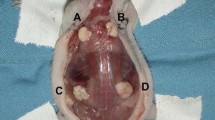Abstract
Background
Despite efforts of plastic surgeons in recent years to discover new alternatives, the techniques currently used for restoration of soft tissue defects still have disadvantages. The gold standard for soft tissue reconstruction remains autologous pedicled/free tissue transfer. This technique often results in high rates of operative morbidity and donor site deformity. Results obtained by autologous fat tissue transfer usually are disappointing because of a high graft resorption rate with unpredictable outcomes. Different tissue engineering approaches have been used in the past to generate adipose tissue. However, long-term results in terms of volume persistence have been disappointing.
Methods
In this study, different concentrations of undifferentiated human preadipocytes in fibrin were injected into athymic nude mice (n = 8). Mice that had fibrin injection without cells served as control subjects (n = 8). The specimens were explanted after 1, 2, 6, and 9 months, with subsequent qualitative and quantitative analysis of adipose tissue formation by histologic and image analysis.
Results
Within the first 4 weeks after initial volume reduction of the implants, the volume and shape of the implants with preadipocytes remained stable. The implants without cells were completely resorbed within 3 weeks. Histologic analysis demonstrated generation of stable adipose tissue with no signs of an inflammatory response or evidence of tissue necrosis in the implants containing preadipocytes. The best results were obtained after implantation of 30 million preadipocytes. Adipose tissue formation was not observed in the control group.
Conclusions
The findings demonstrate that long-term stable adipose tissue can be engineered in vivo by simple injection of human preadipocytes using fibrin as a carrier material. After further investigation, this approach may represent an alternative to the techniques currently used for soft tissue restoration.









Similar content being viewed by others
References
Alhadlaq A, Tang M, Mao JJ: Engineered adipose tissue from human mesenchymal stem cells maintains predefined shape and dimension: Implications in soft tissue augmentation and reconstruction. Tissue Eng 11:556–566, 2005
Bjorntorp P, Karlsson M, Pettersson P, Sypniewska G: Differentiation and function of rat adipocyte precursor cells in primary culture. J Lipid Res 21:714–723, 1980
Borges J, Mueller MC, Torio-Padron N, et al. Engineered adipose tissue supplied by functional microvessels. Tissue Eng 9:1263–12701, 2003
Borges J, Tegtmeier FT, Torio-Padron N, et al. Chorioallantoic membrane angiogenesis model for tissue engineering: A new twist on a classic model. Tissue Eng 9:441–450, 2003
Cho SW, Kim SS, Rhie JW, et al. Engineering of volume-stable adipose tissues. Biomaterials 26:3577–3585, 2005
Ersek RA: Transplantation of purified autologous fat: A 3-year follow-up is disappointing. Plast Reconstr Surg 87:219–227, 1991
Halberstadt C, Austin C, Rowley J, et al: A hydrogel material for plastic and reconstructive applications injected into the subcutaneous space of a sheep. Tissue Eng 8:309–319, 2002
Har-Shai Y, Lindenbaum E, Ben-Itzhak O, Hirshowitz B: Large liponecrotic pseudocyst formation following cheek augmentation by fat injection. Aesth Plast Surg 20:417–419, 1996
Hemmrich K, von Heimburg D, Rendchen R, et al: Implantation of preadipocyte-loaded hyaluronic acid-based scaffolds into nude mice to evaluate potential for soft tissue engineering. Biomaterials 26:7025–7037, 2005
Henriksen TF, Holmich LR, Fryzek JP, et al. Incidence and severity of short-term complications after breast augmentation: Results from a nationwide breast implant registry. Ann Plast Surg 51:531–539, 2003
Klein AW, Rish DC: Substances for soft tissue augmentation: Collagen and silicone. J Dermatol Surg Oncol 11:337–339, 1985
Langer R, Vacanti JP: Tissue engineering. Science 260:920–926, 1993
Maillard G: Liponecrotic cysts after augmentation mammaplasty with fat injections. Aesth Plast Surg 18:405–406, 1994
Mandrekas A, Zambacos G, Kittas C: Cyst formation after fat injection. Plast Reconstr Surg 102:1708–1709, 1998
Marler JJ, Guha A, Rowley J, et al: Soft tissue augmentation with injectable alginate and syngeneic fibroblasts. Plast Reconstr Surg 105:2049–2058, 2000
Patel PN, Gobin AS, West JL, Patrick CW Jr: Poly(ethylene glycol) hydrogel system supports preadipocyte viability, adhesion, and proliferation. Tissue Eng 11:1498–1505, 2005
Patrick CW Jr, Chauvin PB, Hobley J, Reece GP: Preadipocyte seeded PLGA scaffolds for adipose tissue engineering. Tissue Eng 5:139–151, 1999
Patrick CW Jr, Zheng B, Johnston C, Reece GP: Long-term implantation of preadipocyte-seeded PLGA scaffolds. Tissue Eng 8:283–293, 2002
Peer LA: The neglected free fat graft, its behavior and clinical use. Am J Surg 92:40–47, 1956
Romeis B: Mikroskopische Technik. München, Wien, Baltimore: Urban & Schwarzenberg, 1989
Rousou J, Levitsky S, Gonzalez-Lavin L, et al. Randomized clinical trial of fibrin sealant in patients undergoing resternotomy or reoperation after cardiac operations: A multicenter study. J Thorac Cardiovasc Surg 97:194–203, 1989
Schoeller T, Lille S, Wechselberger G, et al. Histomorphologic and volumetric analysis of implanted autologous preadipocyte cultures suspended in fibrin glue: A potential new source for tissue augmentation. Aesth Plast Surg 25:57–63, 2001
Sommer B, Sattler G: Current concepts of fat graft survival: Histology of aspirated adipose tissue and review of the literature. Dermatol Surg 26:1159–1166, 2000
Stark GB, Kaiser HW: Cologne Burn Centre experience with glycerol-preserved allogeneic skin: Part II. Combination with autologous cultured keratinocytes. Burns 20:34–38, 1994
Van RL, Bayliss CE, Roncari DA: Cytological and enzymological characterization of adult human adipocyte precursors in culture. J Clin Invest 58:699–704, 1976
von Heimburg D, Zachariah S, Low A, Pallua N: Influence of different biodegradable carriers on the in vivo behavior of human adipose precursor cells. Plast Reconstr Surg 108: 411–420, 2001
Wechselberger G, Russell RC, Neumeister MW, et al. Successful transplantation of three tissue-engineered cell types using capsule induction technique and fibrin glue as a delivery vehicle. Plast Reconstr Surg 110:123–129, 2002
Ye Q, Zund G, Benedikt P, et al. Fibrin gel as a three-dimensional matrix in cardiovascular tissue engineering. Eur J Cardiothorac Surg 17:587–591, 2000
Author information
Authors and Affiliations
Corresponding author
Rights and permissions
About this article
Cite this article
Torio-Padron, N., Baerlecken, N., Momeni, A. et al. Engineering of Adipose Tissue by Injection of Human Preadipocytes in Fibrin. Aesth Plast Surg 31, 285–293 (2007). https://doi.org/10.1007/s00266-006-0221-6
Published:
Issue Date:
DOI: https://doi.org/10.1007/s00266-006-0221-6



